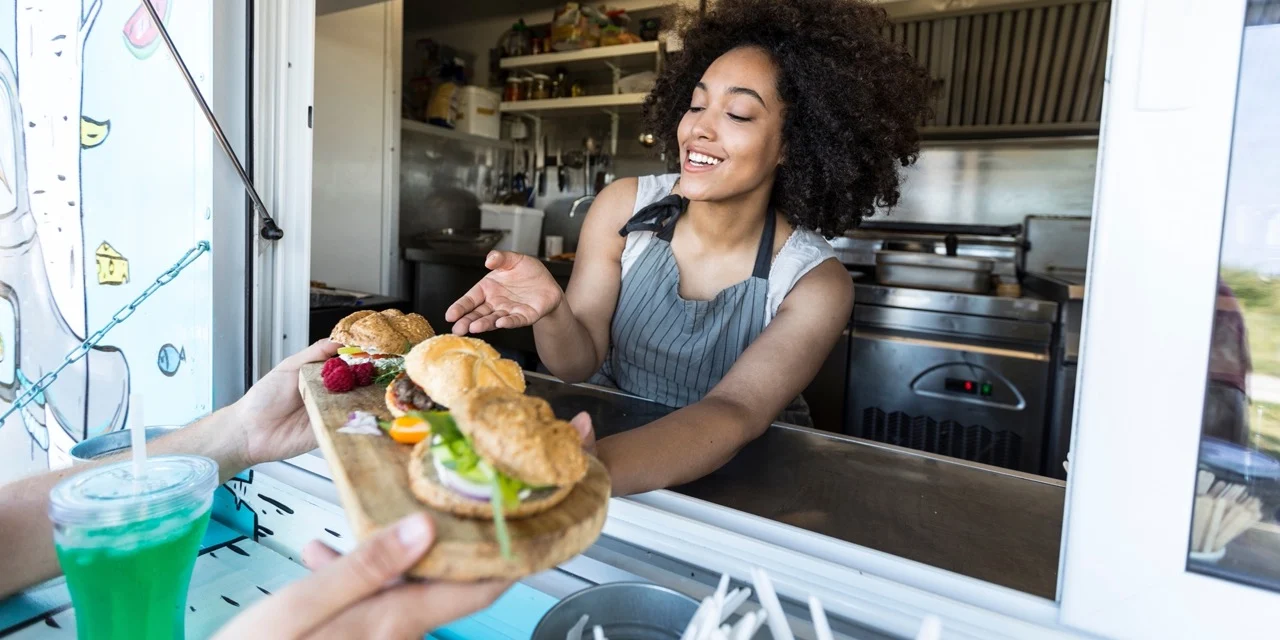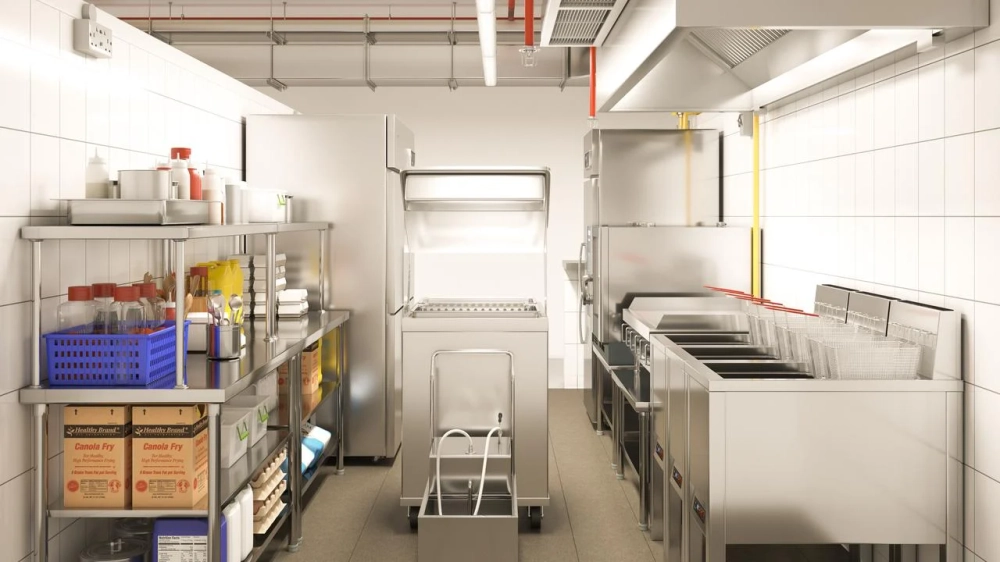How Much Do Food Trucks Make and Are They Profitable?
Table of Contents
CloudKitchens
How many tacos can be delivered from a 1000sqft restaurant?
The same amount as a 200sqft ghost kitchen.

Food trucks are an appealing option for entrepreneurs new to their local food scene. They can travel just about anywhere, and the startup capital and overhead costs pale in comparison to traditional brick-and-mortar restaurants.
But there are still important questions to consider when learning how to start a food truck: are food trucks profitable? And how much do food trucks make?
While revenue averages vary based on location, breaking even in the food truck industry takes hard work, business savvy, and culinary expertise. To help potential food truck owners figure out how much they can expect to make, we’re exploring a few critical elements of the business: startup costs, monthly costs, profit margins, and the pros and cons of the food truck model.
Cost to start a food truck
Before we can answer the question, “Are food trucks profitable?” we need to break down how much it costs to start one. Let’s examine your potential startup costs as a food truck owner.
1. Getting a truck
- Used food trucks: These trucks have already been converted to mobile kitchens or they were purpose-built for mobile food prep.
- New food trucks: These trucks are purpose-built, but they don’t have any previous owners.
- Used trucks to convert: These pre-owned trucks were built for another purpose (like cargo transport or emergency medical services), but entrepreneurs can convert them into kitchens.
- New trucks to convert: These trucks are like their used counterparts above, but they don’t have previous owners.
Data from today’s market suggests that it could cost anywhere between $50,000 and $200,000 to purchase a food truck. Used trucks without kitchens are likely the cheapest to purchase, but conversion costs will be significant. The most expensive but easiest option is likely a brand-new, purpose-built food truck.
2. Getting equipment
If you purchase a food truck that still needs to be converted into a mobile kitchen, you’ll have to invest in equipment like:
- Hood fans
- Gas ranges
- Fridges and freezers
- Sinks
- Fryers
- Soup kettles
But even if you purchase a purpose-built truck, you’ll still need other tools to start making food (and sales):
- Prep equipment like Utensils, Pots and pans, Safety gear like aprons and oven mitts
- A Point-of-Sale system (POS)
- A wifi connection (unless you’re planning to be cash only)
When it comes to costs, this equipment varies in price based on region, brand, and new/used status. If you’re looking to cut start-up costs, remember that you could rent some of these tools.
3. Permitting and licensing
Complying with regulations and maintaining licenses and permits can be one of the most expensive elements of running a food truck—but regulatory costs can vary widely based on location.
A recent industry report suggests that, on average, food truck owners spend over $28,000 per year on licenses, permits, and legal compliance. In Boston (one of the most expensive cities to operate a food truck), owners can expect to spend more than $39,000 per year on regulatory compliance. In Portland, however, regulatory costs can be as low as $5,400 per year.
To best estimate your permitting and licensing costs, consider asking your local chamber of commerce for a local report or a fee estimate.
Average food truck costs (monthly)
While you’ll have to account for startup costs in your break-even calculation, you’ll also have to accommodate regular operating costs for:
- Consumables, including Ingredients, Supplies (e.g., utensils, plates, napkins), Fuel (e.g., propane for gas ranges, truck fuel, and generator fuel)
- Staffing, including Wages, Benefits, Uniforms, Training
- Vehicle maintenance
- Insurance (for your truck and your business)
- Parking and storage
- Marketing
- Professional advice (e.g., a CPA during tax season)
It’s difficult to estimate how much you’ll spend on each of the items above, but there are certainly some cost-saving measures you can take to keep your costs down:
- Buying as many ingredients in bulk as possible
- Selling in locations close to your parking location
- Parking your vehicle on your own property
- Hiring staff with food truck experience (to save on training costs)
- Completing marketing tasks yourself
Food truck profit margin
Are food trucks profitable? Concepts with consistently high-profit margins can be.
Your net profit margin is expressed as a percentage, and you can use a basic formula to calculate it:
| [ Sales Revenue – Cost of doing Business* ] ÷ Sales Revenue x 100 = Net Profit Margin *Cost of doing business = Cost of Good Sold (COGS) + Operating Expenses + Interest + Taxes |
Essentially, your profit margin describes the percentage of sales that have turned into profits. If your profit margin is too low, you must either:
- Decrease your costs, or
- Increase your sales by raising your prices or growing your customer base
Profit margins in food service as a whole average between 3 and 8%. But to reach a profit margin in the positives, you’ll need to break even on your startup costs.
Breaking even for a food truck
To truly break even, you’ll need to meet two separate criteria:
- Your lifetime revenue eclipses your startup costs
- Your monthly revenue is greater than your monthly operational costs
Reaching profitability in any new business venture takes time, and the same is true for food truck owners. But unless you go into debt to start your food truck, you can survive for a while even if you only meet the second criterion above.
Let’s break down a hypothetical. Let’s assume you spent $100,000 on a truck, you spent another $50,000 on other startup costs, your total monthly operational costs are $15,000/month, and your average gross sales are $18,000/month. Let’s also assume that you didn’t take out a loan for startup costs. Here’s how your fledgling business might run:
- If you’re consistently making $18,000 in sales each month and your costs are consistently $15,000, you’ve achieved a 17% profit margin. Nothing to shake a stick at.
- If these average sales and costs are consistent, and you don’t have to spend any money on unexpected expenses (like truck or equipment repairs), you should have an extra $3,000/month to save.
- If you spent $150,000 total on startup costs, it’ll take you just over 4 years to break even on your startup expenses: ($150,000 ÷ $3,000) ÷ 12 months/year = 4.17 years.
These numbers are only hypotheticals, and this is a bit of an oversimplification. Your costs and sales are likely to fluctuate, and you’ll probably spend something on vehicle repairs, equipment replacement, or some other unforeseen expenses in those four years.
But the takeaway is that breaking even on your startup costs and becoming truly profitable takes patience. If you’re looking to make a fortune quickly, running a food truck might not be for you.
Pros & Cons of the food truck model
| Pros | Cons |
|---|---|
| Flexibility | Startup costs |
| Forced minimalism | Vehicle reliability concerns |
| Scalability | You have to seek out customers |
Pros of the food truck model
Flexibility
While you should be open as often as possible to reach profitability quickly, the food truck model offers a lot of flexibility in scheduling. Food trucks also offer flexibility in location. If sales start to fizzle out at one parking location, it’s easy to pick up and move.
Forced minimalism
Massive menus and large dining rooms can cripple new restaurants. If you open a food truck, the truck space alone forces some degree of gradual scale: there’s only so much you can make in the back of a truck.
Scalability
When it’s time to grow, scaling a food truck is slightly less intimidating than scaling a brick-and-mortar restaurant. While you’ll still be (essentially) doubling your operating cost and risk if you purchase a second truck, the scale of your investment is much lower than it would be if you opened a second traditional restaurant location.
Cons of the food truck model
While they offer some advantages, the food truck model also features some drawbacks.
Startup costs
While they aren’t as high as they would be for a brick-and-mortar concept, startup costs for a food truck are still high.
Operating with any sort of storefront (mobile or otherwise) is costly—if you’re looking to start a food service business, there are certainly innovative ways to get your food to hungry customers with a lower startup investment.
Vehicle reliability concerns
Centering an entire business around one vehicle can be risky: vehicles break down. While things can certainly also go wrong in brick-and-mortar restaurants, building issues are generally less common than mechanical issues.
Even purpose-built food truck designers must overcome the fact that at their core, trucks aren’t designed to be kitchens. Wear and tear can stack up fast, a fender-bender could disrupt business for multiple days, and you increase your risk of unforeseen mechanical problems as you rack up mileage.
You have to seek out customers
Successful food trucks seek out customers by:
- Joining food truck rallies or similar events
- Getting hired for special events
- Partnering with another business, like a brewery or bar without an in-house food option
Simply put, you have to seek out customers when you run a food truck. While brick-and-mortar restaurateurs only have to do market research to find one excellent location, food truck owners have to consider multiple possible locations.
You have to meet customers where they are—and, unlike you would with traditional food delivery, you have to bring your kitchen with you.
Skip the startup phase with CloudKitchens
How much do food trucks make? It’s hard to pin down an average number, but startup and monthly costs can be massive hurdles for mobile kitchens to overcome. But they aren’t the only option for ambitious restaurateurs looking to bring food to their customers.
Consider an innovative delivery-only model: a food concept without a sit-in dining room that delivers quality food via third-party delivery services. All you need to get started is a commercial kitchen.
CloudKitchens connects delivery-only restaurant concepts with ghost kitchens—facilities dedicated to cooking. We also streamline delivery and help you keep costs down (and profit margins up).
If you’re looking for the secret ingredient for growing your business, learn more about how CloudKitchens can help put your restaurant on the map. There are also a variety of available ghost kitchens in places like Austin, NYC, and Los Angeles, allowing you to increase or expand your food production in bustling cities across the United States.
Explore ghost kitchen locations across the US:
- Ghost kitchens in San Francisco
- Ghost kitchens in LA
- Ghost kitchens in NYC
- Ghost Kitchens in Toronto
- Ghost Kitchens in Atlanta
- Ghost Kitchens in Dallas
- Ghost Kitchens in Chicago
- Ghost Kitchens in Denver
- Ghost Kitchens in Miami
| DISCLAIMER: This information is provided for general informational purposes only and the content does not constitute an endorsement. CloudKitchens does not warrant the accuracy or completeness of any information, text, images/graphics, links, or other content contained within the blog content. We recommend that you consult with financial, legal, and business professionals for advice specific to your situation. |
Sources:
Roaming Hunger. The Real Cost to Buy a Food Truck (2023 Edition). https://roaminghunger.com/blog/13143/how-much-does-a-food-truck-cost
Food Truck Nation. US Chamber of Commerce Foundation Food Truck Index. https://www.foodtrucknation.us/wp-content/themes/food-truck-nation/Food-Truck-Nation-Full-Report.pdf
Investopedia. Profit Margin Defined: How to Calculate and Compare. https://www.investopedia.com/terms/p/profitmargin.asp
Restaurant365. Average Profit Margins for a Restaurant. https://www.restaurant365.com/blog/what-is-the-average-profit-margin-for-a-restaurant/
CarGurus. What to Expect When Buying a High-Mileage Car. https://www.cargurus.com/Cars/articles/what-to-expect-when-buying-a-high-mileage-car
More insights & stories
There’s more where that came from.
Get in the know and check out our additional insights



